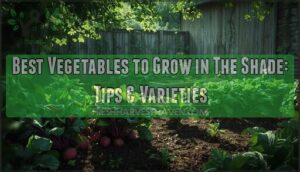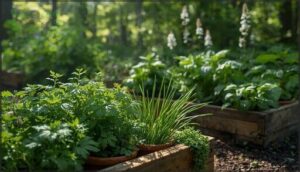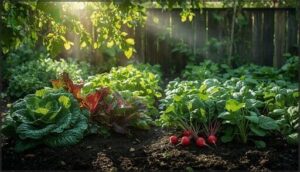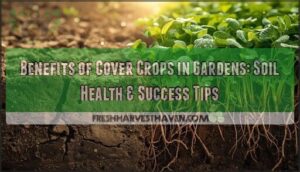This site is supported by our readers. We may earn a commission, at no cost to you, if you purchase through links.

Leafy greens actually taste sweeter in partial shade, staying tender longer without the bitter edge that comes from heat stress. Root vegetables like beets and carrots develop perfectly well underground regardless of whether their foliage basks in full sun or dappled light.
You’ll discover that shade gardening isn’t about settling for less—it’s about working with your landscape to grow crops that perform better when they’re not scorched by afternoon rays.
Table Of Contents
- Key Takeaways
- Vegetables for Shade Gardens
- Choosing Shade Vegetables
- Shade Garden Requirements
- Maximizing Shade Garden Yield
- Shade Garden Challenges
- Growing Vegetables in Shade
- Frequently Asked Questions (FAQs)
- What is the most shade tolerant vegetable?
- What will grow in 100% shade?
- Which vegetables require the least amount of sun?
- Do any edible plants grow in full shade?
- Can vegetables grow in the shade?
- What vegetables can grow in partial shade?
- Which vegetables are most tolerant of shade?
- What vegetables grow in a shady yard?
- Which vegetables and herbs grow well in shade?
- Can vegetables grow in shade?
- Conclusion
Key Takeaways
- Leafy greens like lettuce, spinach, and kale thrive with just 3-4 hours of daily sunlight, producing sweeter, more tender leaves in partial shade while reducing bolting by 50% compared to full-sun plants.
- Root vegetables including beets, carrots, and radishes adapt well to shade conditions, yielding 70-85% of full-sun crops while developing superior flavor and maintaining higher soil moisture levels.
- Shade gardening success depends on amending soil with 20-30% compost, providing proper drainage through raised beds, and adjusting watering schedules since shaded soil retains moisture 45% longer than sunny areas.
- Strategic garden design using vertical space, companion planting, and crop rotation can maximize yields in shaded areas while reducing disease risk by 50% and boosting overall productivity by up to 48%.
Vegetables for Shade Gardens
You don’t need blazing sun to grow fresh, flavorful vegetables at home. Many crops actually prefer cooler, shadier spots where they can develop tender leaves and sweet roots without stress.
Let’s look at which vegetables thrive when sunlight is limited and how you can make the most of every shaded corner in your garden.
Leafy Greens for Shade
Leafy greens offer the perfect green harvest for partial shade areas. These cool season champions—lettuce, kale, spinach, and arugula—thrive with just 3-4 hours of direct sun. Their shade tolerance actually works in your favor:
- Bolting slows by 50%, extending harvests two to three weeks
- Leaf moisture increases 15-20%, improving tenderness
- You’ll maintain 70% of full-sun yields
- Vitamin content stays within 10% of sun-grown crops
Swiss chard and Asian greens add variety to your shade garden bounty. Understanding shade gardening tips can help you enhance your harvest.
Root Vegetables for Shade
Root vegetables adapt remarkably well to partial shade, though you’ll trade some yield for sweeter flavor. Beets, carrots, radishes, and turnips produce solid harvests with just 3-4 hours of direct sun—expect yields around 70-85% of full-sun crops. Shade actually helps: soil moisture stays 15-30% higher, carrot seeds germinate more reliably, and radishes mature without turning woody. Baby roots harvested early from shaded beds deliver outstanding tenderness and sugar content. Amend your soil with 3-4 inches of compost to support healthy root development in lower light conditions. Understanding shade tolerant plants is vital for optimizing shade garden yields.
Herbs and Specialty Crops for Shade
Beyond root crops, herbs offer your shade garden remarkable versatility. Chives, parsley, cilantro, and mint thrive with just 3-4 hours of sun—they’ll bolt 30% slower than sun-grown plants, extending your harvest window markedly. Shade-tolerant herbs like lemon balm spread vigorously in partial shade, while medicinal plants such as ginseng and black cohosh flourish with minimal light.
Consider these specialty crops:
- Forest gardening with woodland medicinal plants yields premium returns
- Herb polycultures mixing 5+ species boost revenue per square meter
- Container gardening with herbs works perfectly for shade-tolerant vegetable gardening
- Leafy greens like parsley maintain higher moisture and tenderness in shade
Choosing Shade Vegetables
Once you’ve identified the shady spots in your garden, the next step is matching vegetables to those conditions. Success depends on understanding what your plants need beyond just limited light.
Let’s look at the key factors that determine which shade vegetables will thrive in your garden.
Soil and Moisture Needs
Your shade garden’s success starts underground—get the soil right, and everything else falls into place. Shade vegetables thrive in loamy, well-drained soil enriched with 20–30% compost or well-rotted manure to compensate for limited light. This high organic matter content boosts moisture levels and delivers steady nutrients your crops need.
Proper soil preparation makes all the difference:
- Soil composition: Mix in compost or perlite to create loose, friable conditions—especially vital for carrots and radishes that need freedom to expand
- Drainage systems: Build raised beds to reduce waterlogging risk by 30–50% compared to flat gardens
- Water retention: Apply 2–3 inches of mulch to maintain consistent moisture without saturating roots
- Moisture levels: Check soil weekly; shade gardens usually need 1 to 1.5 inches of water
- Soil conditions: Aim for pH 6.0–7.0 and test before planting for peak nutrient uptake
Well-drained soil prevents fungal diseases while keeping roots healthy and productive.
Temperature and Light Requirements
Getting your temperature and light balance right makes or breaks your shade-tolerant vegetable gardening success. Most cool-season vegetables thrive between 59–72°F, where photosynthesis rates remain strong even in partial shade.
You need 3–6 hours of direct sunlight daily—the minimum light intensity for acceptable yields. Under these growing conditions, shade tolerance becomes your advantage: temperatures above 86°F trigger bolting, so filtered sunlight actually protects your crops while maintaining productivity.
Fertilization and Mulching
Optimizing nutrient delivery and moisture retention transforms shade-grown vegetables from struggling survivors into productive crops. Your fertilizer choice directly impacts yield: organic fertilizers like vermicompost boost hot pepper yields by 18% compared to conventional options, while nitrogen-rich formulations (5-1-1 NPK ratio) boost leafy green production in low-light zones. Mulch materials create stable microclimates—barley straw and vegetable residue reduce soil temperature fluctuations by 3–5°C while improving moisture retention.
- Apply 2–3 inches of organic mulch to maintain consistent soil conditioning
- Feed with compost tea or vermicompost every 4–6 weeks for steady nutrient cycling
- Use well-drained soil amended with biochar to increase yields 15–27%
- Increase fertilizer frequency 10–20% over full-sun schedules
Shade Garden Requirements
Setting up your shade garden for success means going beyond just picking the right plants. You’ll need to focus on variety selection, smart planning practices, and physical support systems that help your crops thrive with limited light.
Let’s look at three essential requirements that will optimize your shade garden’s productivity.
Selecting High Yielding Varieties
Think of variety selection as stacking the deck in your favor—you can’t change how much light you’ve got, but you can plant cultivars built to thrive in it. Focus on shade-tolerant varieties with documented performance in low-light conditions. Kale types like Red Russian and Nero Toscana maintain 85% of their full-sun yield with just 3–4 hours of daily light, while loose-leaf lettuce such as Oak Leaf can produce up to 1 pound per square foot.
For cool-season vegetables and leafy green vegetables, prioritize seed quality and choose varieties labeled for bolt resistance and compact growth. Asian greens like mizuna consistently deliver over 12 ounces per plant in shade-tolerant vegetable gardening setups, proving that smart crop selection drives real yield optimization.
Implementing Crop Rotation
Rotating your plants isn’t just good practice—it’s your insurance policy against crop failure. Move leafy greens and cool-season crops to fresh spots annually, keeping brassicas away from their previous beds for at least three years.
This crop rotation slashes disease risk by 50% and boosts yields by 27-48% in shade-tolerant vegetable gardening. Strategic rotation schedules deliver real pest control and soil renewal without chemicals.
Crop rotation cuts disease in half and boosts yields up to 48% while naturally controlling pests and renewing soil
Providing Support and Pruning
Structural frameworks aren’t optional in shade gardening—they’re your ticket to higher yields. Use A-frame trellises at least six feet tall for pole beans, maximizing vertical gardening space while letting you tuck celery beneath for double cropping.
Pruning techniques transform leggy shade-tolerant vegetables into productive plants: remove lower leaves regularly to boost airflow and cut disease by 20%. For tomatoes and peppers, prune to four main stems under shade management, increasing marketable yields nearly 50% through better crop optimization.
Maximizing Shade Garden Yield
Getting the most from your shade garden means working with what you’ve got, not fighting against it. You can still harvest generous crops when you understand how to make every bit of available light count, keep moisture levels just right, and stay ahead of common problems.
Let’s walk through three key strategies that’ll help your shaded vegetables thrive and produce their best.
Managing Limited Light
Managing limited light in shade gardening starts with understanding photosynthesis rates and light intensity thresholds. Your shade-tolerant vegetable gardening success hinges on achieving 100-300 μmol/m²/s of light for ideal growth.
Position reflective surfaces to redirect rays onto leafy greens and implement supplemental lighting during short winter days.
Growing vegetables in shade requires strategic spacing—give plants room to capture every precious photon while maintaining airflow that prevents disease in your partial shade garden.
Preventing Overwatering
While managing light is half the battle, water control will make or break your shade-tolerant vegetable gardening efforts. Reduced sunlight means slower evaporation, so your soil holds moisture 45% longer than sunny beds—setting up conditions for root rot if you’re not careful.
Check soil conditions for vegetables by testing the top two inches before watering. When well-drained soil crumbles easily, you’re ready to irrigate. Deep weekly watering beats daily sprinkling, cutting root disease by 25% while preventing bolting in leafy greens.
Smart irrigation management makes a real difference:
- Install soil moisture sensors to reduce water waste by 30-50%
- Incorporate compost as drainage solutions, improving flow by 40%
- Use raised beds for root rot prevention—they slash standing water by 55%
Managing soil moisture properly keeps your shade vegetables thriving, not drowning.
Dealing With Pests and Diseases
Even with perfect watering, you’ll face pests and diseases in shade gardens—fungal issues jump 60% in damp, shaded spots. Check your leafy greens weekly for aphids and slugs, the usual suspects in shade-tolerant vegetable gardening.
Pest control methods like floating row covers cut infestations by 60%, while proper spacing improves airflow and drops fungal problems 35%.
Disease prevention starts with shade garden hygiene—remove old plant debris to slash transmission rates by half. Integrated management combining organic solutions keeps your crops healthy without harsh chemicals.
Shade Garden Challenges
You’ve tackled the basics of shade gardening, but turning limited light into a thriving vegetable patch comes with its own set of hurdles.
The good news is that smart design choices can help you work around these constraints and make the most of every inch.
Let’s look at three practical strategies that address common shade garden challenges head-on.
Using Vertical Space
Vertical gardening unlocks untapped potential in shady spots where ground space runs short. You can transform fences, walls, and trellises into productive zones for shade-tolerant crops like leafy greens, peas, and compact beans. Tiered planting systems and aerial support structures boost your harvest while improving airflow around plants—cutting disease problems by more than a third.
Here’s how to enhance vertical space in your shade garden:
- Stack containers on shelves or racks to create multiple growing levels for lettuce, spinach, and herbs
- Install trellises along partially shaded walls to support climbing vegetables while improving light exposure
- Use hanging baskets for trailing varieties, freeing ground space for root crops and leafy vegetables
Creating Shade Garden Design
Your shade garden layout starts with smart plant layering—tall vegetables like beans and kale in back, mid-height Swiss chard and beets in the middle, leafy greens like lettuce up front. This structured approach gives every shade-tolerant vegetable access to available light while creating visual appeal.
Mix broad-leaved crops with fine-textured herbs to add dimension. Group plants in odd numbers and repeat patterns for balance.
Well-prepared soil and strategic shade structures support healthy growth in partial shade conditions.
Incorporating Companion Planting
Companion planting creates natural pest control networks in your shade garden. Pair brassicas like kale with mint or chives—they suppress soil-borne fungi by 21% and cut aphid damage by 35%. Plant nasturtiums near cabbage for trap cropping, or add basil beside shade-tolerant vegetables to reduce disease by 25%.
Legumes boost soil enrichment through nitrogen fixation, supporting leafy greens with 22% more nutrients. This crop diversification also strengthens pollinator support and microclimate management.
Growing Vegetables in Shade
Growing vegetables in shade doesn’t mean settling for less—you just need to choose crops that work with your garden’s conditions. Cool-season vegetables naturally prefer lower light and cooler temperatures, making them perfect candidates for partial shade.
Let’s look at which vegetables thrive in shadier spots and how to set yourself up for success.
Cool Season Vegetables
Cool-season vegetables are your secret weapon for making partial shade work in your favor. These shade-tolerant crops thrive when temperatures hover between 50-65°F, with photosynthesis peaking at about two-thirds of full sunlight. You’ll find success with:
- Leafy greens like lettuce and kale that resist bolting in shade
- Root vegetables such as beets and carrots requiring just 3 hours of filtered sun
- Swiss chard tolerating low light while maintaining steady root development
- Spinach preserving tenderness throughout extended growing periods
Strategic garden planning around these coolseason crops transforms challenging spaces into productive harvests.
Legumes and Beans for Shade
Bush beans give you the freedom to turn underutilized shade into productive garden space. With just 4-5 hours of sunlight, these legumes produce viable yields while fixing nitrogen—a win for soil health. Your best bet? Stick with bush varieties over pole types, as they handle low light better. Cowpea and lablab lead the pack for shade tolerance, maintaining strong growth even when light drops by 60-80%.
| Legume Type | Shade Tolerance | Sunlight Needed |
|---|---|---|
| Bush Beans | Moderate | 4-5 hours |
| Cowpea | High | 3-4 hours |
| Lablab | High | 3-4 hours |
Keep in mind: moderate shade (30-40%) works best. Push beyond 70%, and you’ll need those shade-tolerant cultivars to maintain decent harvests.
Tips for Successful Shade Gardening
Your shade garden’s success hinges on three pillars: light, soil, and moisture balance. Start by adding 2-4 inches of organic mulch to retain moisture and suppress weeds, while amending soil with compost for better drainage. Thin overhead branches to boost light penetration—even modest pruning makes a real difference.
Space plants generously to optimize available sunlight, and adjust watering carefully since shade areas retain moisture longer. This smart shade garden planning transforms challenging spots into productive growing zones for shade-tolerant vegetables.
Frequently Asked Questions (FAQs)
What is the most shade tolerant vegetable?
While many gardeners obsess over sunbeams like cats, spinach laughs at the sun-worshippers. This shade-tolerant champion thrives with just 3-4 hours of daily light, making it your shadiest garden ally for consistent harvests.
What will grow in 100% shade?
True 100% shade—receiving under two hours of direct sunlight—won’t support traditional vegetables. However, microgreens, sprouts, and mushrooms thrive indoors without sunlight, offering nutrient-dense options for deep shade gardening situations.
Which vegetables require the least amount of sun?
Leafy greens like lettuce, spinach, and arugula are your best bet—thriving on just 2-4 hours of daily sun.
Root crops including radishes and beets also flourish as shade-tolerant veggies with minimal sun requirements.
Do any edible plants grow in full shade?
Very few edible shade-tolerant plants truly thrive in full shade—areas with less than two hours of direct sunlight daily.
Arugula and malabar spinach tolerate these low-light conditions better than most shade-tolerant vegetables, which still need some sun.
Can vegetables grow in the shade?
Approximately 30-50% of photosynthesis remains possible under reduced light, meaning you can grow shade-tolerant vegetables successfully.
Leafy greens like lettuce, spinach, and kale thrive with just 3-4 hours of sunlight, while root vegetables such as radishes and beets adapt well to partial shade conditions.
What vegetables can grow in partial shade?
Your shade-tolerant vegetables include leafy greens like lettuce, spinach, and kale, which thrive with just 3-4 hours of sunlight.
Root vegetables such as radishes, beets, and carrots also produce excellent yields in partial shade conditions.
Which vegetables are most tolerant of shade?
Your most shade-tolerant vegetables include kale, spinach, and lettuce—leafy greens thriving with just 3-4 hours of daily sunlight.
Swiss chard, arugula, and Asian greens like bok choy also excel in partial shade, producing reliable harvests despite limited light.
What vegetables grow in a shady yard?
Your shady yard can still yield a productive harvest. Try lettuce and spinach—they’re shade-loving veggies needing just 3-4 hours of sun.
These low-light gardening champions produce tender leaves even in partial sun crops.
Which vegetables and herbs grow well in shade?
Leafy greens like lettuce, spinach, kale, and arugula flourish in partial shade with just 3-4 hours of sunlight. Cool season crops such as Swiss chard and shade-tolerant herbs like parsley, cilantro, and mint grow exceptionally well too.
Can vegetables grow in shade?
You’ll find that many vegetables adapt beautifully to partial shade. Leafy greens like lettuce and spinach actually flourish with just 3-4 hours of sunlight, while shade-tolerant root crops like radishes and beets maintain impressive garden productivity.
Conclusion
Like Eden’s forgotten corners blooming with unexpected abundance, your shaded spaces hold untapped potential. You’ve learned the best vegetables to grow in the shade—from tender lettuce that sweetens in filtered light to sturdy kale that laughs at limited sun.
Your north-facing beds and tree-shaded patches aren’t gardening challenges; they’re opportunities to cultivate crops that wilt under full exposure. Start planting where others see limitations, and you’ll harvest where sunlight feared to tread.
- https://www.theprairiehomestead.com/2020/02/vegetables-that-grow-in-the-shade.html
- https://www.weedemandreap.com/planning-your-garden-vegetables/
- https://pmc.ncbi.nlm.nih.gov/articles/PMC11367508/
- https://mygardenlife.com/edibles/vegetables-that-grow-in-shade
- https://www.pubs.ext.vt.edu/426/426-312/426-312.html











